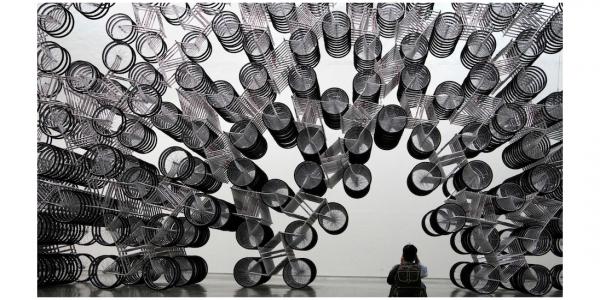We asked Yuqian Yan, a postdoctoral fellow in Chinese performance cultures in the Department of East Asian Languages & Cultures, to respond to the Kemper Art Museum’s exhibition, Ai Weiwei: Bare Life, and to attend the museum’s sold-out Q&A with Ai Weiwei on September 26. (The exhibit continues through January 5.) Here, she brings her expertise in spectatorship and Chinese performance culture to bear on the controversial Chinese artist and filmmaker’s works, which draw attention to the struggles of millions of people in China and around the world.
A dissident, a human rights fighter and an artist in exile, Ai Weiwei never fails to stir excitement for the titles he wears. He first gained international acclaim beyond the art world for leading investigations of student casualties during the 2008 Sichuan Earthquake. His harsh criticism of the Chinese government’s mismanagement and censorship of information made him “the most dangerous person in China,” as Ai puts it. Commemoration of the earthquake victims remains a reoccurring subject of Ai’s works, taking a wide range of material and media forms. At Ai Weiwei’s 2019 St. Louis exhibition, curator Sabine Eckmann insightfully organizes his pre- and post-earthquake focuses into two major themes: Rupture and Bare Life.
These two sections of the exhibition Ai Weiwei: Bare Life at Washington University’s Kemper Art Museum address the pivotal transition in Ai’s career from playful criticism of cultural rupture to earnest concerns for human life conditions. What underlines the two parts is his uncompromising iconoclasm that firmly places himself in opposition to authoritative powers. The title section consists of earthquake-related works and Ai’s more recent pieces on global war refugees, spatially divided by the spectacular site-specific installation Forever Bicycle.
Ai’s earlier obsession with craftsmanship, materiality and grand scale persists in his pungent political criticisms. Twisted marble rebars are placed on top of coffin-shaped boxes, symbolizing bodies crashed by collapsed buildings during the earthquake. The boxes are not simply cases that house the rebar but are masterfully crafted artifacts, made from one of the most precious hardwoods in China. Ever since his controversial Dropping of a Han Dynasty Urn (1995), Ai Weiwei has incorporated highly valuable materials into his artworks, often for the purpose of foregrounding the very process of destruction. He also works the other way around, assembling debris into aesthetic forms that are visually astonishing and sometimes can even afford a momentary escape from political implications.

Now, it seems that Ai Weiwei is ready to move on, as he has discovered the most treasurable material to work with — bare human life and struggles for survival under coercive and destructive forces. Such epiphany is best encapsulated in Illumination (2009), an iconic image of Ai provocatively holding a flashing cellphone against the policemen following him. It was taken when he was in custody in Sichuan for getting involved in the earthquake investigation. The image positions Ai as a fearless fighter against oppressive power. Fearless because he holds the light of illumination; because of his awareness of being watched, by both the Chinese authority and Western media; because he has confidence in his power of turning suffering into art that anyone with humanistic concerns would and should care. Illumination is positioned at a conspicuous spot in the exhibition space, marking the visual focus of the visitors as they look past or walk through an archway formed by 720 bicycles. It is also framed by the exhibition entrance and readily visible even before one steps in. Juxtaposed with works about global refugees instead of grouped with other China-related works, Ai Weiwei in Illumination manifests his identification with displaced refugees as he, too, had been stripped bare and is now banished from his own country.
During the Q&A with Eckmann, Ai claimed that he had shifted his concerns from China to universal humanity and increasingly saw himself as a global citizen. Does it mean that Ai is demanding a rupture from his earlier craft-oriented artworks and culturally and politically specific criticisms? Indeed, a truly good artist does not need to wave a national flag to call attention to his/her works, and a devoted human rights activist fights for any of mankind in need. In this sense, Ai’s displacement, or more precisely replacement, in Berlin provides him a chance to prove that he is more than a Chinese dissident, but a world artist who acts upon genuine humanistic concerns for all. This new direction that Ai Weiwei points toward in his St. Louis exhibition is worth expecting.



